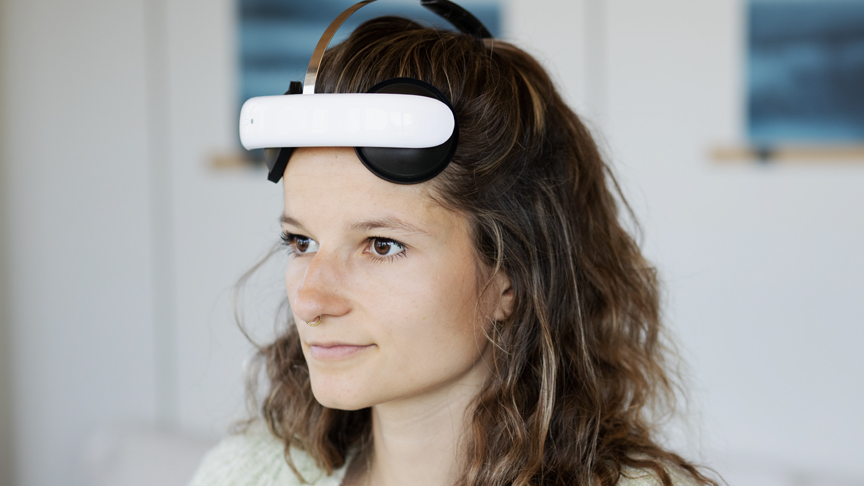NewsMakers
Does listening to calming music at bedtime actually help you sleep?
Listening to calming music at bedtime improved sleep quality in older adults, and calming music was much better at improving sleep quality than rhythmic music.

A new study published in the Journal of the American Geriatrics Society has found that listening to music can help older adults sleep better.
Researchers from the National Cheng Kung University Hospital in Taiwan combined the results of past studies to understand the effect that listening to music can have on the quality of older adults’ sleep. Their work suggests that:
- Older adults (ages 60 and up) living at home sleep better when they listen to music for 30 minutes to one hour at bedtime.
- Calm music improves older adults’ sleep quality better than rhythmic music does.
- Older adults should listen to music for more than four weeks to see the most benefit from listening to music.
Why Older Adults Have Trouble Getting a Good Night’s Sleep
As we age, our sleep cycles change and make a good night’s sleep harder to achieve. What does it really mean to get a good night’s sleep? If you wake up rested and ready to start your day, you probably slept deeply the night before. But if you’re tired during the day, need coffee to keep you going, or wake up several times during the night, you may not be getting the deep sleep you need. According to the National Institute on Aging, older adults need seven to nine hours of sleep each night.
But studies have shown that 40 to 70 percent of older adults have sleep problems and over 40 percent have insomnia, meaning they wake up often during the night or too early in the morning. Sleep problems can make you feel irritable and depressed, can cause memory problems, and can even lead to falls or accidents.
How the Researchers Studied the Effect of Music on Older Adults’ Quality of Sleep
For their study, the researchers searched for past studies that tested the effect of listening to music on older adults with sleep problems who live at home. They looked at five studies with 288 participants. Half of these people listened to music; the other half got the usual or no treatment for their sleep problems. People who were treated with music listened to either calming or rhythmic music for 30 minutes to one hour, over a period ranging from two days to three months. (Calming music has slow tempo of 60 to 80 beats per minute and a smooth melody, while rhythmic music is faster and louder.) All participants answered questions about how well they thought they were sleeping. Each participant ended up with a score between 0 and 21 for the quality of their sleep.
The researchers looked at the difference in average scores for:
- people who listened to music compared to people who did not listen to music;
- people who listened to calm music compared to people who listened to rhythmic music;
- and people who listened to music for less than four weeks compared to people who listened to music for more than four weeks.
What the Researchers Learned
Listening to calming music at bedtime improved sleep quality in older adults, and calming music was much better at improving sleep quality than rhythmic music. The researchers said that calming music may improve sleep by slowing your heart rate and breathing, and lowering your blood pressure. This, in turn helps lower your levels of stress and anxiety.
Researchers also learned that listening to music for longer than four weeks is better at improving sleep quality than listening to music for a shorter length of time.
What this Study Means for You
If you’re having trouble sleeping, listening to music can be a safe, effective, and easy way to help you fall and stay asleep. It may also reduce your need for medication to help you sleep.
NewsMakers
At-home brain stimulation prevents depression relapse in 3 out of 4 patients, study finds
As up to 85% of people with depression experience relapse during treatment, effective tools for relapse prevention are lagging.

A study, and largest of its kind, has found that at-home brain stimulation can prevent relapse of major depressive disorder in 75% of patients. Published in the Journal of Affective Disorders, the PSYLECT study tracked the long-term effects of home-based transcranial direct current stimulation (tDCS) therapy combined with online behavioral support. The findings revealed that non-drug, at-home treatment could help many patients maintain recovery from depression over time.
In the study, participants who had completed their initial depression treatment had to use at-home brain stimulation twice a week for six months.
Researchers monitored their progress to see whether the therapy could prevent relapse without ongoing clinical support. By the end of the follow-up period, only six of the 71 patients experienced a return of depressive symptoms, while 11 discontinued treatment.
The results showed that most participants maintained recovery using brain stimulation therapy alone, without the need for in-person visits or additional interventions.
As up to 85% of people with depression experience relapse during treatment, effective tools for relapse prevention are lagging.
According to the study, at-home and remotely supervised tDCS therapy can be an effective and scalable option: it achieves results comparable to in-clinic treatment, but can increase access and lower costs, as it doesn’t require clinic visits to receive therapy sessions.
“Home-based brain stimulation bridges a major treatment gap, helping patients sustain long-term recovery after antidepressants or psychotherapy,” said Erin Lee, CEO of Flow Neuroscience, the company behind a tDCS device for depression used in the study. “Many people struggle to pay for visits or travelling to the clinic, or simply are too busy to attend several sessions a week. This is when at-home therapy comes to the rescue.”
Erin Lee added that at-home tDCS-based relapse prevention can be cost-effective for clinics, too, as it reduces waiting times and frees up clinicians.
For patients, another benefit of at-home treatment is high adherence.
“Many people with a history of depression might find it easier to stick to home-based therapy, as it’s less effort compared to regular in-clinic visits,” noted Dr. Kultar Singh Garcha, a GP and Medical Director at Flow Neuroscience. “Even months into treatment, many patients still feel physically and emotionally exhausted, so lowering the effort can help them keep going.”
Beyond accessibility and scalability, researchers found at-home brain stimulation to be safe and well-tolerated, with minimal side effects like scalp itching or headaches. By the end of the study, 40% of participants reported no adverse events at all.
The study was led by the University of São Paulo Medical School and conducted in collaboration with the Ludwig-Maximilians University in Munich, Germany, as well as the University of Ghent, Belgium, Spaulding Rehabilitation Hospital, and Massachusetts General Hospital.
Flow Neuroscience’s medical device, used in the study, is CE-certified and has regulatory approval for depression treatment in the UK, EU, Australia, Switzerland, Hong Kong, and other countries. It is backed by both clinical studies and real-world data of over 50,000 users.
By delivering gentle electrical currents to the brain, the headset regulates activity in the prefrontal cortex, the part of the brain involved in mood regulation and stress response. It is often underactive in people with depression.
“For decades, relapse has been one of the biggest challenges in depression treatment, but this is finally changing now,” said Erin Lee. “We are certain that with home-based brain stimulation therapy, effective and non-drug relapse prevention will become a new mental health care standard.”
NewsMakers
Millennials and Gen Zs prioritize health, purpose, financial independence, but health and wellness gaps persist
Younger Filipinos are placing greater emphasis on healthspan, purpose, and financial independence. However, the study also revealed that while 83% of young respondents have good knowledge about health and wellness, only 76% say they are taking sufficient action to consistently practice healthy habits.

While millennials and Gen Zs in the Philippines are reshaping what it means to live well and live long, significant gaps between awareness and action jeopardize their health, wellness, and longevity aspirations, a new study by Manulife Philippines has found.
According to “#FYP: Future-proofing Young Pinoys: Examining Health and Longevity Perspectives, Sentiments, and Aspirations of Millennials and Gen Zs,” which was conducted among 500 respondents across the Philippines, younger Filipinos are placing greater emphasis on healthspan, purpose, and financial independence. However, the study also revealed that while 83% of young respondents have good knowledge about health and wellness, only 76% say they are taking sufficient action to consistently practice healthy habits.
“With a median age of 26.1, the Philippines has one of the youngest populations in Asia. Our latest study highlights the need to support younger generations in translating their health, wellness, and longevity aspirations into meaningful action. We found that millennials and Gen Zs are motivated to live healthier lives, but barriers like stress, excessive screen time, and sleep deprivation, among many others are holding them back from achieving this goal,” said Rahul Hora, President and Chief Executive Officer, Manulife Philippines.
Motivated to be healthy, but stress gets in the way; Millennial women among the most affected
The study found that millennials and Gen Zs are not short of motivation to pursue their health and wellness goals. While 64% said they are pursuing health to avoid getting sick, and 44% said they want to minimize potential medical expenses, many are equally driven by their personal well-being and self-image about feeling and looking good: 44% said they want to look good or fit, and 43% said they want to look youthful.
Younger Filipinos, especially women, are also putting more focus on healthspan, or the number of the years we live healthily, over lifespan. According to the survey, 60% of female respondents prefer to prolong their healthspans, while 53% of males prefer to prolong their lifespans.
Filipino millennials and Gen Zs face notable health and wellness gaps, from monitoring to their actual wellness behaviors:
- Young Filipinos show significant gaps in health monitoring (awareness vs what they actually monitor), particularly in mobility (24%), nutrition (23%), and cholesterol levels (20%). Gender differences are evident, with young women struggling more with nutritional monitoring (27%) and young men facing greater challenges in mobility monitoring (28%).
- Many young Filipinos find it difficult to consistently maintain healthy sleeping habits (20%), achieve work-life balance (19%), and follow a balanced diet (15%). Women report a larger gap in achieving work-life balance at 22%, compared to the 15% gap among men.
- Stress is the most prominent barrier to wellness, affecting 64% of respondents. Millennials report higher stress levels than Gen Zs (69% vs. 58%), and women are more affected than men (73% vs. 55%). Notably, 76% of millennial women say stress prevents them from pursuing their desired wellbeing—the highest among all generational and gender groups.
- Modern lifestyle habits further compound these issues, with excessive screen time impacting 48% and sleep deprivation affecting 45% of young Filipinos. Trends such as “bedrotting” and “doomscrolling” reflect how contemporary behaviors are undermining their wellness goals.
“We’re seeing that for young Filipinos, intent alone isn’t sufficient. While many are motivated to pursue healthier lives, they’re facing a complex mix of stressors and lifestyle gaps, which make it difficult to follow through. These habits quietly derail their ability to prioritize wellness. That’s why the next step is to find ways to embed wellness into their daily routine. By offering health and wellness-focused programs and collaborations with likeminded partners, we are helping them bridge the gap between intention and action, turning wellness goals into sustainable, everyday behaviors supporting their long-term health and longevity aspirations,” added Hora.
Younger Filipinos view age positively and prioritize attaining purpose and living independently than being illness-free
According to the study, 96% of millennials and Gen Zs surveyed believe aging is a natural process that should be embraced with positivity, while 91% of the respondents believe that living a meaningful life is more important than living a long one. The study revealed a striking perspective on aging priorities, with 83% of respondents believing that living independently and being able to do things that matter most to them is more important than being illness-free.
Millennials surveyed focus more on physical health and family relationships as they age. Gen Zs, on the other hand, lean toward self-discovery, purpose, and making an impact. Only 13% of both generations consider maximizing lifespan as a top priority, with men showing slightly higher interest (17%) compared to women (8%).
“The findings reveal that young Filipinos see aging not as decline, but as a chance to live with purpose and independence,” Hora said. “It is therefore crucial that we create opportunities and support systems for them to live better at every stage of their lives. This means investing in holistic wellness programs, accessible financial health education, as well as tools that address both physical and mental needs, tailored especially for younger generations navigating various stressors of the modern world.”
“As one of the country’s longest-serving insurers, Manulife Philippines is deeply committed to supporting younger generations of Filipinos in their journey toward financial independence and longevity. Through our innovative insurance and investment solutions, and our nationwide network of over 10,000 professional financial advisors, we aim to empower millennials and Gen Zs to live fuller, healthier lives with purpose and confidence as they age,” said Hora.
Financial independence: Younger Filipinos’ ultimate longevity concern
When it comes to living a longer life but also “adding life to years,” financial security tops the list of concerns for both generations. Among the respondents, 74% believe that longevity is a blessing only if they have sufficient financial resources, with running out of money being their greatest worry (61%). Millennials and Gen Zs agree that mental health is a top longevity concern (36% and 47%, respectively). Millennials surveyed are more concerned about keeping ties with children (37%), while Gen Zs are more concerned about living their desired lifestyle (39%).
Gaining financial independence is also a top longevity priority for young Filipinos (52%), followed by family relationships (36%) and physical health (33%). Women, however, prioritize financial independence significantly more than men (60% vs. 44%). This gender gap reflects broader structural realities women face in the Philippines. Despite having longer life expectancies (69.9 vs 63.4), women have lower labor force participation (52.9% vs 76.3%) and are prone to career interruptions due to family and caregiving responsibilities. These factors make financial independence especially urgent for women, who must plan for longer retirement years with potentially fewer financial opportunities.
Financial planning remains one of the many challenges the youth face. Gen Zs surveyed estimate needing PHP22.3 million to achieve financial independence upon retirement, while millennials estimate PHP18.4 million. Yet only 20% of respondents have very high confidence in achieving these goals. Despite the challenges, young Filipinos take proactive steps. Among those who prioritize financial independence, 65% save part of their income, 45% purchase insurance, and 43% actively broaden their financial knowledge. However, 68% admit that sustaining investments remains difficult.
“It’s encouraging to see today’s younger generations starting to take more proactive steps toward financial planning. We’re seeing a shift in mindset, where millennials and Gen Zs are actively saving, purchasing insurance, and expanding their financial literacy. These are promising signs,” said Aira Gaspar, President and Chief Executive Officer, Manulife Investments Philippines.
“The key now is to help them bridge the gap between intention and sustained action, through accessible, flexible investment strategies that evolve with their life stages, financial capabilities, and aspirations. By enabling them with the right tools and guidance, we can help turn financial independence into a tangible, achievable reality for our younger customers in the Philippines,” added Gaspar.
NewsMakers
Drinking any amount of alcohol likely increases dementia risk
Even light drinking—generally thought to be protective, based on observational studies—is unlikely to lower the risk, which rises in tandem with the quantity of alcohol consumed.

Drinking any amount of alcohol likely increases the risk of dementia, suggests the largest combined observational and genetic study to date, published online in BMJ Evidence Based Medicine.
Even light drinking—generally thought to be protective, based on observational studies—is unlikely to lower the risk, which rises in tandem with the quantity of alcohol consumed, the research indicates.
Current thinking suggests that there might be an ‘optimal dose’ of alcohol for brain health, but most of these studies have focused on older people and/or didn’t differentiate between former and lifelong non-drinkers, complicating efforts to infer causality, note the researchers.
To try and circumnavigate these issues and strengthen the evidence base, the researchers drew on observational data and genetic methods (Mendelian randomisation) from two large biological databanks for the entire ‘dose’ range of alcohol consumption.
These were the US Million Veteran Program (MVP), which includes people of European, African, and Latin American ancestry, and the UK Biobank (UKB), which includes people of predominantly European ancestry.
Participants who were aged 56–72 at baseline, were monitored from recruitment until their first dementia diagnosis, death, or the date of last follow-up (December 2019 for MVP and January 2022 for UKB), whichever came first. The average monitoring period was 4 years for the US group, and 12 for the UK group.
Alcohol consumption was derived from questionnaire responses—over 90% of participants said they drank alcohol—and the Alcohol Use Disorders Identification Test (AUDIT-C) clinical screening tool. This screens for hazardous drinking patterns, including the frequency of binge drinking (6 or more drinks at a time).
In all, 559,559 participants from both groups were included in observational analyses, 14,540 of whom developed dementia of any type during the monitoring period:10,564 in the US group; and 3976 in the UK group. And 48,034 died: 28,738 in the US group and 19,296 in the UK group.
Observational analyses revealed U-shaped associations between alcohol and dementia risk: compared with light drinkers (fewer than 7 drinks a week) a 41% higher risk was observed among non-drinkers and heavy drinkers consuming 40 or more drinks a week, rising to a 51% higher risk among those who were alcohol dependent.
Mendelian randomisation genetic analyses drew on key data from multiple large individual genome-wide association studies (GWAS) of dementia, involving a total of 2.4 million participants to ascertain lifetime (rather than current) genetically predicted risks.
Mendelian randomisation leverages genetic data, minimising the impact of other potentially influential factors, to estimate causal effects: genomic risk for a trait (in this case, alcohol consumption) essentially stands in for the trait itself.
Three genetic measures related to alcohol use were used as different exposures, to study the impact on dementia risk of alcohol quantity, as well as problematic and dependent drinking.
These exposures were: self-reported weekly drinks (641 independent genetic variants); problematic ‘risky’ drinking (80 genetic variants); and alcohol dependency (66 genetic variants).
Higher genetic risk for all 3 exposure levels was associated with an increased risk of dementia, with a linear increase in dementia risk the higher the alcohol consumption.
For example, an extra 1-3 drinks a week was associated with a 15% higher risk. And a doubling in the genetic risk of alcohol dependency was associated with a 16% increase in dementia risk.
But no U-shaped association was found between alcohol intake and dementia, and no protective effects of low levels of alcohol intake were observed. Instead, dementia risk steadily increased with more genetically predicted drinking.
What’s more, those who went on to develop dementia typically drank less over time in the years preceding their diagnosis, suggesting that reverse causation—whereby early cognitive decline leads to reduced alcohol consumption—underlies the supposed protective effects of alcohol found in previous observational studies, say the researchers.
They acknowledge that a principal limitation of their findings is that the strongest statistical associations were found in people of European ancestry, because of the numbers of participants of this ethnic heritage studied. Mendelian randomisation also relies on assumptions that can’t be verified, they add.
Nevertheless, they suggest that their findings “challenge the notion that low levels of alcohol are neuroprotective.”
And they conclude: “Our study findings support a detrimental effect of all types of alcohol consumption on dementia risk, with no evidence supporting the previously suggested protective effect of moderate drinking.
“The pattern of reduced alcohol use before dementia diagnosis observed in our study underscores the complexity of inferring causality from observational data, especially in ageing populations.
“Our findings highlight the importance of considering reverse causation and residual confounding in studies of alcohol and dementia, and they suggest that reducing alcohol consumption may be an important strategy for dementia prevention.”
-

 Product Showcase4 weeks ago
Product Showcase4 weeks agoManulife Philippines ‘Time to MOVE’ symposium focuses on health and longevity
-

 Product Showcase2 weeks ago
Product Showcase2 weeks agoKorean brand Wells showcases 23 years of engineering innovation
-

 NewsMakers2 weeks ago
NewsMakers2 weeks agoMillennials and Gen Zs prioritize health, purpose, financial independence, but health and wellness gaps persist
-

 Destinations3 weeks ago
Destinations3 weeks agoChecking religious expression at Montemaria in Batangas
-

 Product Showcase2 weeks ago
Product Showcase2 weeks agoAIA Philippines CEO named Executive Champion of the Year in Asia
-

 Destinations4 weeks ago
Destinations4 weeks agoBeach-hunting led to Malabrigo Beach
-

 Product Showcase2 weeks ago
Product Showcase2 weeks agoManulife brings personalized gut health insights to PH
-

 Destinations2 weeks ago
Destinations2 weeks agoChecking out Street Halo-Halo Milky Ice
















